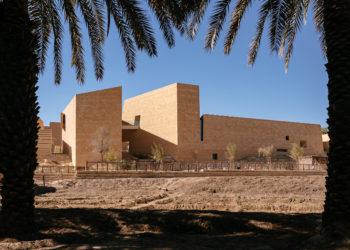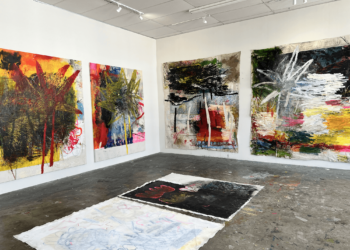Part 3
The full feature on HAIL! The Dark Lioness has been published in three parts. You can read the rest of the interview here & here.
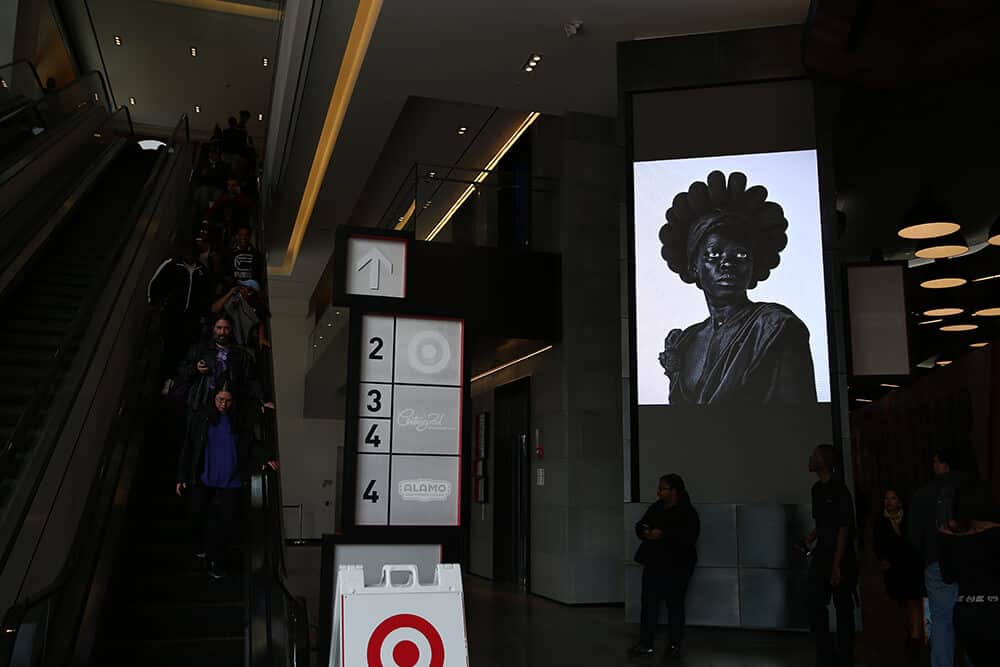 Installation shot of Zanele Muholi’s intervention in City Point, New York City, as part of Performa 17. Courtesy of Performa.
Installation shot of Zanele Muholi’s intervention in City Point, New York City, as part of Performa 17. Courtesy of Performa.
Ellen Agnew: You have documented the black LGBTQI+ community – what was it like turning the lens on yourself for Somnyama Ngonyama?
Zanele Muholi: Somnyama Ngonyama has been okay, and painful, and an unnerving experience to look at yourself, because you have a lot of flaws. You don’t love every body part you posses, it’s just given to you, it’s yours.
I needed to reconnect with me, to connect with the fragile, inner soul, inner child, that no matter how old I become, there are still a lot of things and events that really make me cry. I’m not as strong, or as brave as I seem to present me in different spaces. There are many things that trigger thoughts that irritate me, that wake me up at four in the morning because I haven’t faced them. And I made a choice not to see a shrink, because I have to deal with me.
So Somnyama Ngonyama is aimed at dealing with the personal, with the me – all the flaws, and all the jerk. I also reference many cases in history that really irritated me, that have to do with race and racism. The story of my mother for instance – Bester Muholi was born in 1936, and she passed away in 2009. Everytime I walk into a space I feel her presence – the presence of this human, this person who gave birth to me. She allowed me the opportunity to express myself, and gave me the space and the opportunity to be able to converse with you right now. So that’s my mother, and one of the images in Somnyama Ngonyama relates to her story.
Another image I produced relates to my sister, and it’s called Senzeni. This image was produced in 2016 when I was on residency at Castle House in North Carolina. The week I produced Senzeni I was bleeding heavily – like a heavy period you won’t believe – I think I was changing my pads four a five times a day. I’m not worried about men when I talk about menstruation. They dig deep into the same hole that really, pounded blood, and unfortunately it’s the same space where most women are raped. I won’t even be sorry or apologetic for speaking like this, and I don’t want you to edit out what I just said – I don’t usually speak like this, and I’ve given you my time.
So I was bleeding, I bled. We come from a dysfunctional family, really, and when we are kind of popular to other people, it doesn’t mean that we are at peace with the self, or how we project ourselves.
My sister – Basizeni Margaret Muholi – celebrated her 60th birthday on the 11th October 2016. When my mother was at work, Basizeni was more like my mother. She was young, and she had her first born at the age of 16. Her first born is five years younger than me – her name is Thembeka, she lives in Cape Town, and I love her dearly. One of the photographs in Somnyama Ngonyama is named after her.
Before you even start school, your sister is pregnant, and as she’s still trying to process all this mess, another sister falls pregnant, and she’s still trying to deal with that, another sister falls pregnant, and another sister. So I come from a big family, though my parents are no longer alive – I still have my siblings – I have two sisters left now, and one brother, and me. See I’m neither male or female, I’m me.
So my sister, Basizeni, celebrated her 60th birthday on the 11th. I wasn’t there, I was in North Carolina on residency, but I asked one of my friends to interview her on the radio, and another friend to produce amazing photographs of her birthday, and I sent money home for it to be spectacular. Sounds like a movie, right?
I was due to come home at the end of October – my sister was sick, she had heart problems and other health issues – and as I was trying to figure out how to tell her how she treated me as a child, and how some of my work is influenced by her, she got worse and worse. I got a phone call on the 29th October that she had passed away – the very same sister that I had issues with, that I really wished to tell about how she had treated me had shaped me and my work.
My body reacted to that, I think. But that’s how Basizeni XI – as I stood there, wherever I was, that image is of a bleeding human, my body shedding what I was going through at that time. Over the past few years, I’ve been bleeding, bleeding without understanding what’s going on – but when my sister died, I knew that something had just happened. I knew that I had fibroids, but I didn’t know that they were growing aggressively in my system.
My sister had the most beautiful send-off ever – like a high-profile person. I documented her funeral with my phone, and we cremated her on the 4th November. Her ashes were thrown, or buried, with her late husband. December came and I was overdue for an operation to remove the fibroids – and when I went to the doctor, my fibroids had grown so big that it was like I was five months pregnant – that’s how hectic they were, like big. It’s all documented, don’t worry.
I was operated on the 18th December – so these are all the layers, you know. This is just to say how my projects come to life. I don’t just shoot.
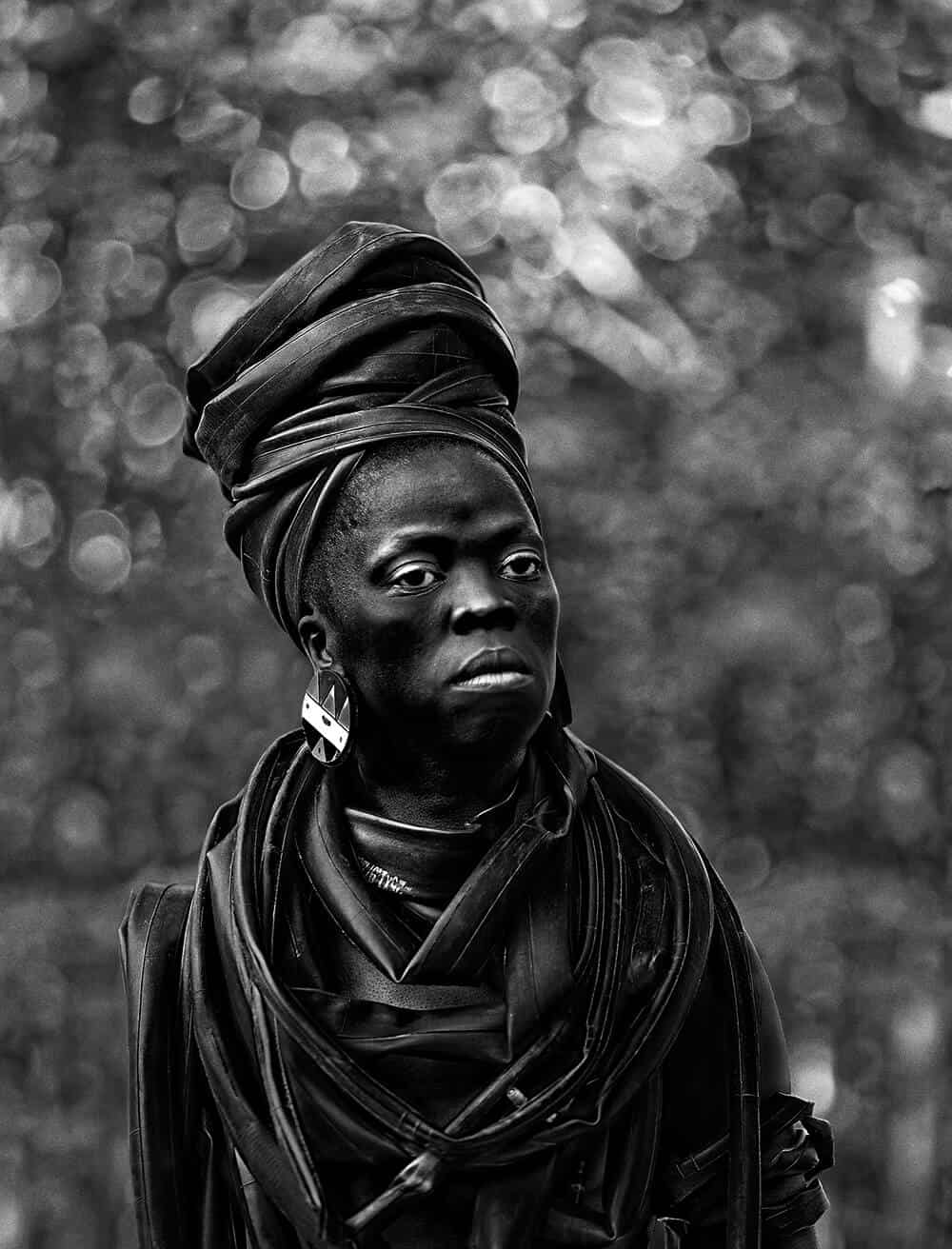 Zanele Muholi, Basizeni XI from Somnyama Ngonyama, 2016. © Zanele Muholi. Courtesy of the artist.
Zanele Muholi, Basizeni XI from Somnyama Ngonyama, 2016. © Zanele Muholi. Courtesy of the artist.
That story then becomes another project – how to deal with pain, how to deal with your personal experience in various ways. Before my big operation, I was told that I needed to have an iron transfusion, that I had low blood pressure. I was just moving on, thinking that I was strong, but my body was really getting worse and worse. So I see in this portrait, in Basizeni XI, a lot of tubes, and it speaks about a medical apartheid, one that continues to refuse people access to medication, simply because they can’t afford it. It speaks of the poor system that is in place. That’s medicine – starting with me, I was saved because I could afford to pay for those medical bills, but in reality, you have a number of women in this country, especially black women, who have fibroids, and they don’t even know what fibroids are because they don’t have access to gynecologists. I don’t just shoot for the sake of shooting – I have issues, because it hurts and it makes you cry, if you have a heart.
I was operated on for about two and a half hours. I lost a lot of blood, and I had to take a lot of leave to recover. It was a testing and painful period, and I was on leave for about three months. The doctor told me not to even try the basic things – don’t soak yourself in water, don’t have sex in six weeks. I was focused on what I was dealing with, and needed to heal. I also couldn’t fly for two, to three months – I was stuck in bed, and suffered from depression. So that’s how fibroids disorganised my life.
My first trip abroad after the operation was to Japan, where ZaKi was taken. After that I flew to America, and then I flew to Paris, France, and following that I flew to Berlin, Germany. I experienced racism in Berlin, and produced an image which also forms a part of ‘Somnyama Ngonyama’. So every image relates to a historical event in my life, and it’s beyond just turning the lens on myself. It’s deeper than that. Remember that I’m not just doing this for show – these are my experiences, and I will tell you what happened before each and every photograph was taken. It’s not easy, it’s one of those painful things.
The props you use, can you tell us more about them, and with the individual experiences, and how – you take quite a few of your photographs in hotel rooms, I believe?
Hotel rooms, wherever I wake up. Outside, and so on and so on. I don’t work in a studio, but I requested one of my team members to organise a studio in Cape Town for ‘Brave Beauties’ – they needed somewhere like what they see on television, so the images you see in the ‘Inkanyiso’ room in Stevenson are beautifully captured because they were taken in a studio. Otherwise I just shoot wherever I wake up.
Can you tell us about the props you use? And the space’s influence on the portraits?
Replace the word “props” with “materials”. It could be gloves, the inner tubes of bicycle wheels, pegs, scissors, wool, travel pillows, belts, gas masks, boxes – everything I use are materials that others use daily, but not how I use them in my portraits – I just use them differently. The hairbands that I use in Phaphama at Cassilhaus, North Carolina – many people use these bands, but they never use them like how I have – to create a sculptural type thing.
These materials have meaning to me. In Basizeni XI, Cassilhaus, North Carolina it relates to necklacing, where Impimpis were necklaced during the apartheid years in South Africa. With Sifikile, Nuoro, Italy – scissors are used to cut paper, but then you read about cases where somebody was stabbed and killed by someone with a pair of scissors, and you pull that reference, and it speaks about our society – there is such violence, where does this violence come from?
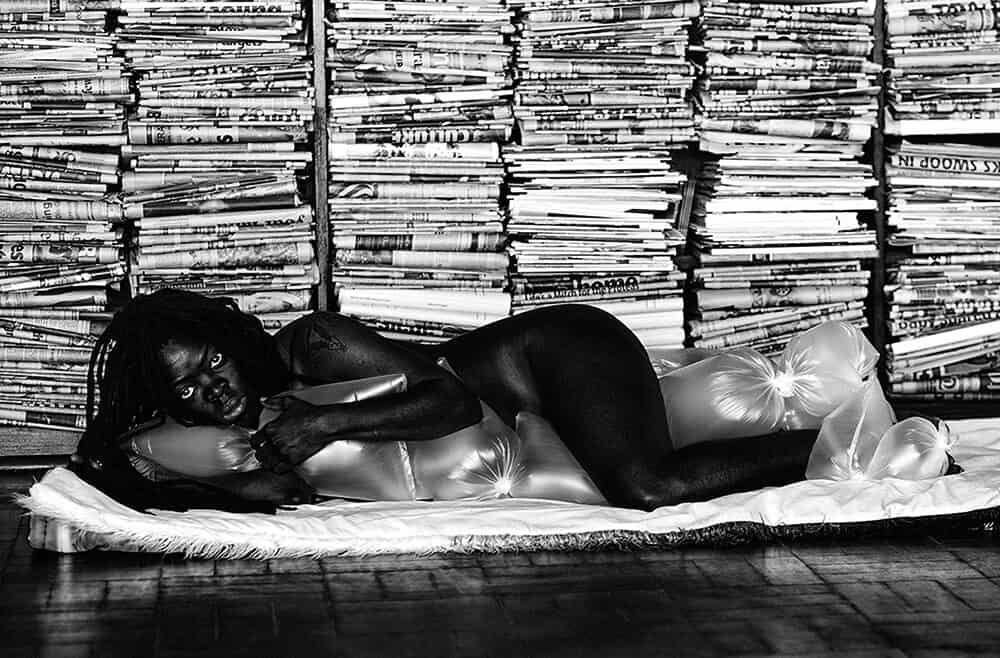 Zanele Muholi, Julile I, Parktown, Johannesburg from Somnyama Ngonyama, 2016. © Zanele Muholi. Courtesy of the artist.
Zanele Muholi, Julile I, Parktown, Johannesburg from Somnyama Ngonyama, 2016. © Zanele Muholi. Courtesy of the artist.
These images are beautiful images, but a lot of people were brutally killed like this – the necklace became the tool by which those people were murdered.
None of these images speak to beauty, but at the same time I’m also claiming my beauty as a black person – which is not spoken about much or projected in racial issues.
Another word that I don’t use in my photo lingo, or visual language, is “subject.” I don’t refer to the people I photograph as “subjects.” The people in my photographs are participants, they are partaking in a visual history project, and they’re people that I care about dearly, and people that I respect as they shape the kind of visual history that I want to read about or see in South Africa when you think of South African photography. No “subjects.”
And I don’t paint my face black, because I’m black anyways. I increase the contrast during post production, otherwise there’s no painting used.
Have people asked you that before?
Many people have asked why I paint my face black. I don’t paint myself black – I’m black anyway, you know.
The images are taken in various cities around the world. Basizeni XI, Cassilhaus, North Carolina was taken in North Carolina – I was feeling so good but so fragile. My body felt sort of detached, and it was getting worse and worse without me being aware of what I was going through.
ZaKi, Kyoto, Japan was taken in Japan, and Behekezakhe, Parktown was taken at my place in Parktown. Funeka I and S’manga were taken in Amsterdam in 2016 and 2017. I just use a canon on a tripod, with an 85mm lens and sometimes I use a 50mm lens at 2.8 F-stop. The image with the scissors, Sifikile, was taken in Nuoro, Italy, Phaphama was taken at Cassilhaus in North Carolina, and it speaks about gas chambers and people and killing, and I’ve heard that some food we eat – like chicken – is gassed so that they can be slaughtered without pain, which I don’t believe in, and it speaks about the politics of food.
My right side is definitely my good side, so that’s my side, and on my left side you’ll also see a signature of a womb. I have a tattoo, which was done in 2008, of a womb – so you’ll know if it’s my left side in an image because you’ll see the womb. I needed to have a tattoo of something that was symbolic, that could connect people of all genders – whether you are a man or a woman, whether you’re queer or straight, whether you’re female or male – we all come from that womb space.
The image with the shoes, Basizeni II, speaks about activism, solidarity, protest – where all of us are wearing shoes and we are heading forward because we want something to be dealt with in a certain way. I wanted to wear different activist’s shoes, but when I woke up that morning, I felt that I’ve been marching alongside my peers, and each and every pair of shoes I have relates to a particular history in my life, as I walk along, following, and taking justice for many. The shoes became my soul – they became a part of my meaning in life to see change happen in our lives as we continue to fight for LGBTQI+ rights in South Africa and beyond South Africa.
Artists think, and sometimes artists produce political works. They don’t just wake up in the morning and want to be artists. So that personality, turning the lens on myself, is historical and deeply personal. I don’t just do things because I want people to see art – these images have sentimental thoughts, these materials have value in meaning.
Lastly, anything else you’d like to add? The music you like? The colour of your toothbrush?
My favourite colour is black – but that’s not the reason I’m focused on black. I love black and white photography because that’s how I was taught photography. I learnt using analog, and I process most of my work myself. I like to do a lot of work by myself, and on myself, because I get to learn a lot from my mistakes.
My favourite person – a man that I love – is David Goldblatt. Lily and David Goldblatt gave me the opportunity to further my education and sponsored my programme. I studied an MFA in documentary media – and most of my work is documentary, or about documenting, style, everything, straight to the core. So I’m very grateful to these two human beings.
David Goldblatt founded the Market Photo Workshop – the school I attended – and he happened to be my appointed mentor. I requested David to be my mentor because I didn’t want someone to look at my work with a queer eye. And he’s a straight man, and I was challenging him – I think the best way for people to deal with different phobias in life is to work with people who are the opposite. David was kind enough to let me into his space and speak to me in various ways and give me a chance that my family could not afford to give me. He took a risk with me, and he paid for my education abroad – I was just a poor South African, and couldn’t afford the international university fees – but he did that for me. He really did that for me, and I’m so truly grateful for it. I wish that I could tell the world how much the Goldblatt’s have done for so many people like me.
You gave us the school, you had the chance to call it the David Goldblatt School of Photography, but you just let it be the Market Photo Workshop, and it is through you that we have the best school for photography in the country. The best photographers in the country – they come from the Market Photo Workshop.
I come from there, and some of my work is used to teach the current students. And so does Lolo Veleko – a very, very important South African photographer who showcased at various galleries before I even knew that I would become someone. Lolo has done very, very well and she’s really taught us a thing or two.
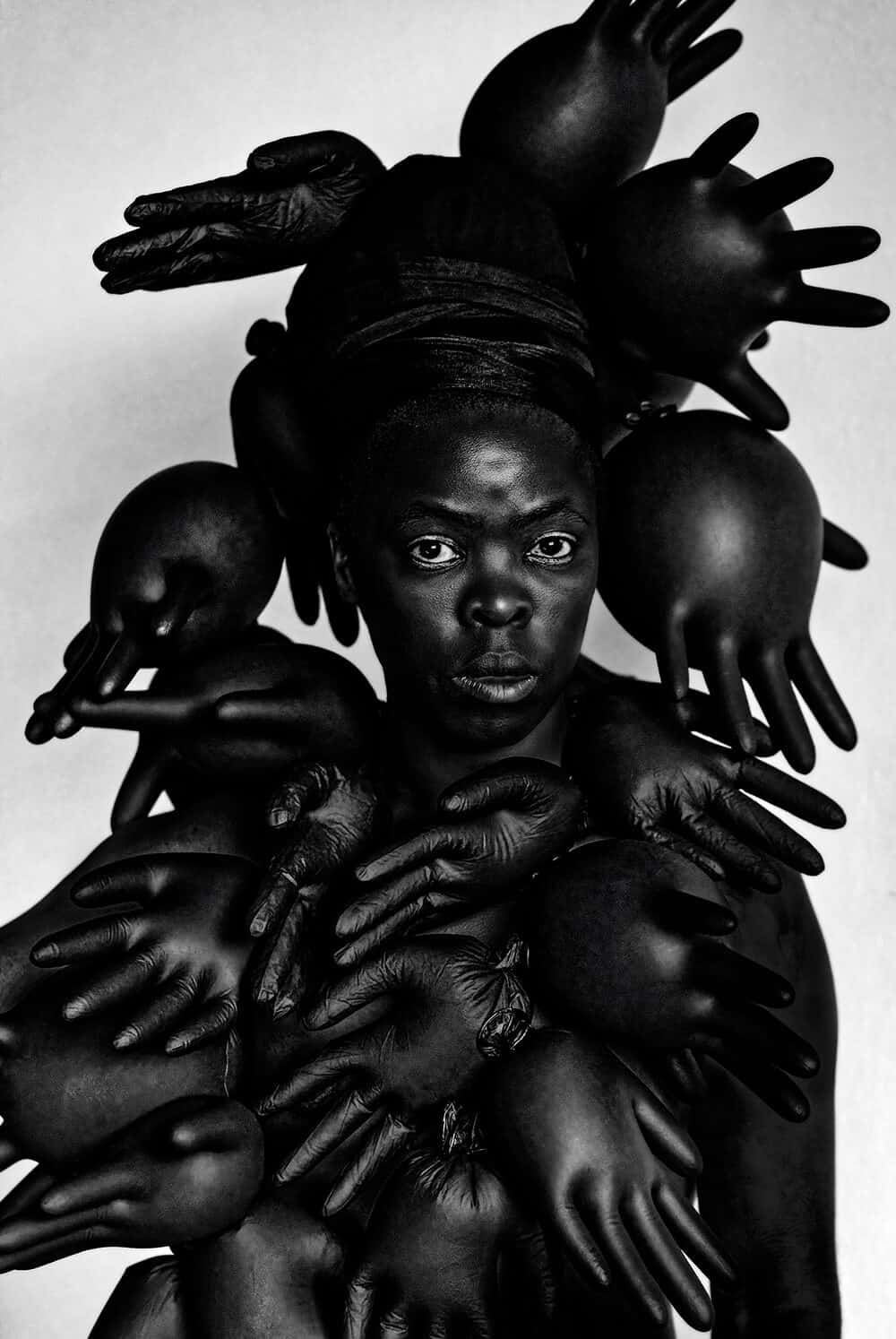 Zanele Muholi, Phila I, Parktown, from Somnyama Ngonyama, 2016. © Zanele Muholi. Courtesy of the artist.
Zanele Muholi, Phila I, Parktown, from Somnyama Ngonyama, 2016. © Zanele Muholi. Courtesy of the artist.
You can find this feature in issue 10 of ART AFRICA, ONE OF US, which celebrates those circumventing the fringe and speaking-up about the issues that have for so long been a part of daily existence.

